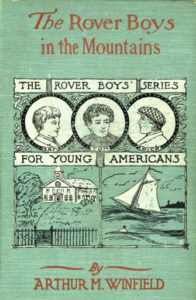
While the focus of this blog is pulp fiction, mainly hero pulps, I have and will continue to delve into areas around the “fringe” of pulp fiction.
This includes the literary forerunners to pulp fiction in the U.S. and overseas, the successors of pulp fiction in paperback, digests, thrillers, and New Pulp, and the adaption of pulp characters into other media such as comics, comic strips, radio, movies/serials, and TV.
An area I have been considering looking at are the various juvenile or children’s series books that somewhat paralleled pulps from the late 1800s until around the 1970s. In particular, I mean the various numbered series of books of teens in mysteries/adventures, usually owned by the publisher and put out under a house name, similar to the hero pulps. (So, no, I won’t be looking at the more recent juvenile/teen fiction series such as Harry Potter, Divergent, Maze Runner, etc.)
One thing I’ve long had a problem with is the view that the hero pulps were aimed at the juvenile reader. Mainly because there were separate works, such as the series books that were explicitly aimed at the juvenile reader, with youthful protagonists. Later there were comics books that also was more aimed at them. The hero pulps always had adult heroes in adult situations, and seems more aimed at a little older reader.
Before the advent of the pulps, there were the story papers and dime novels. Several serial characters appeared in these media. Some were clearly aimed at the juvenile reader, with boy inventor/adventurers like Franke Reade and Jack Wright (which I’ve posted on before), or boy detectives or boy adventurers like the Boys of ’76 and so on. The dime novels also hosted more adult characters like Buffalo Bill and other western heroes, the various detective characters like Nick Carter and the like.
With the replacement of the dime novels with the pulps, the adult series characters made the transition to the pulps, with various western and detective characters like Zorro, Nick Carter, and the like, and later the pulp heroes like The Shadow, Doc Savage, etc.
But the juvenile series characters instead seem to move to series books in hardback, many coming from the Stratemeyer Syndicate which gave us the Rover Boys, Bobbsey Twins, Tom Swift, Hardy Boys, Nancy Drew, and many more.
The Stratemeyer Syndicate was what we would call a book packager today, though they, not the publisher, owned the works. But they worked with the various printing houses of the time like Grosset & Dunlap, Cupples & Leon, Simon & Schuster, and the like. Edward Stratemeyer established the syndicate and originally wrote all the series under a variety of house names, then later got other writers to do the books using his outline and guidelines. The Syndicate kept themselves hidden from the general public. There would be no indication in any of the books they produced that it came from them.
Some of the well-known series — they did a lot of series — and the year they began:
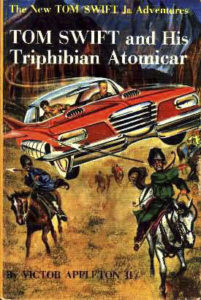
- Rover Boys, 1899, 30 volumes
- Bobbsey Twins, 1904, 72 volumes
- Tom Swift, 1910, 40 volumes
- Bomba, The Jungle Boy, 1926, 20 volumes
- Hardy Boys, 1927, 190 volumes
- Nancy Drew, 1930, 175 volumes
- Tom Swift Jr., 1954, 33 volumes
In 1930, Edward’s daughters took over, especially Harriet Stratemeyer Adams, who took on writing or outlining series as well. In the ’50s they brought out new series and updated old ones like the Hardy Boys and Nancy Drew. In the ’70s they grew frustrated with G&D and wanted to move to Simon & Shuster. This lead to a big trial and shakeout with G&D. Due to this, Grosset & Dunlap got to keep publishing the Hardy Boys and Nancy Drew volumes they had been publishing (and still reprint today), and the Syndicate went with Simon & Schuster, who instead publish the Hardy Boys and Nancy Drew Casebook series, plus new Tom Swift series, etc.
Harriet died in 1982, and her heirs sold off the Syndicate rights to Simon & Schuster in 1984, which is why all new works with these characters come from them.
But the Syndicate was not the only one doing these. Other publishers, including Grosset & Dunlap themselves, as well as Golden/Whitman, Random House, Clover, etc, were producing various juvenile series such as Biff Brewster, Brains Benton, Rick Brant, and others.
In another connection with the pulps, some pulp authors also wrote works in some of these series. Walter Gibson, creator of The Shadow, wrote several Biff Brewster volumes. Charles Spain Verral, longtime writer of Bill Barnes, created Brains Benton and wrote most of the series as well as other juvenile works. W. Ryerson Johnson, who wrote some Doc Savages and several other pulp works, had his own juvenile series, Bob Blake, which ran under his name.
So over the coming months I’ll do postings on those series that interest me. At present, that includes: Tom Swift, Rick Brant, Biff Brewster, Brains Benton, Bob Blake, Bomba the Jungle Boy, Christopher Cool, Danny Dunn, the Three Investigators, and Tom Quest. Sorry, no Hardy Boys, I never found them, nor the girls series, interesting.

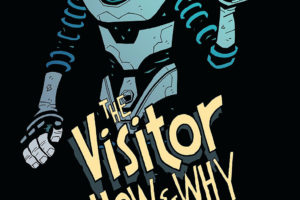
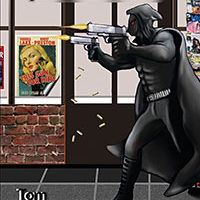
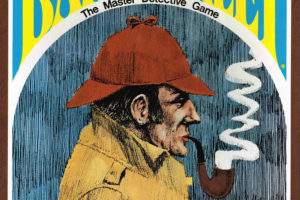
Several writers of pulp magazines began their careers in the story paper and juvenile series book fields. Additional examples include Leslie McFarlane, W. Bert Foster, H.J. Bedford-Jones, Thomson Burtis, Eustace L. Adams, and many others.
There are some typos that should be corrected. Frank Reade, especially Frank Reade Jr., not “Tom Reade” was the story paper and half-dime library inventor hero.
The publisher name was spelled “Dunlap”, not “Dunlop”.
The Stratemeyer Syndicate was the largest entity in the first quarter of the 20th Century acting as a book packager. Many of its techniques were things that Edward Stratemeyer (1862-1930) had learned from his work writing and editing for the story paper and dime novel publishers. This includes the extensive use of house-owned pseudonyms. He called them “trademark pen names”. He also introduced a number of innovations, going far beyond the usual author-publisher relationship to actively market his personal writings (168 books plus many more stories for periodicals) and the products of his Stratemeyer Syndicate.
The publishers were also trying to compete by making outright purchases of stories to be published as juvenile series books. These series were wholly owned by the publishers and no royalties were paid, of course, just the initial payment for the story.
When the Stratemeyer Syndicate arranged for publication with a publishing company, the contract was fairly strong on the side of the publisher. Even if sales were abysmally poor, it was hard and expensive for Stratemeyer to buy back the publisher’s rights in a series or title so it could be taken to another firm. Very low royalty rates (about 4% on the first 10,000 copies sold and 5% afterward) were a concession that the publishers would not renegotiate.
This kind of hold on a series is part of what led to the 1980 lawsuit that you alluded to. It was not so much a case of them wanting to get into the paperback line (they had done so many times before, including 1926 issues from Garden City as thick pulp paperbacks akin to the Magnet and Medal Library formats) but rather to get to a publisher that would actively promote the series. The Syndicate had seen the average sales per volume going down for many years. The retail prices were rising and the number of volumes in print was going up so the royalty checks were larger but the income per book was going down, especially when adjusted for inflation.
Simon & Schuster promised to promote the books in ways that Grosset & Dunlap didn’t feel was necessary. After seeing the Bobbsey Twins 75th anniversary in 1979 pass without note from G&D and learning there were NO PLANS for Nancy Drew’s 50th, it became easier for the Stratemeyer Syndicate to consider the offer from Simon & Schuster.
The Syndicate started to send new titles in several series (Hardy Boys, Nancy Drew, Tom Swift, and the Bobbsey Twins) formerly from G&D as well as reprints from series where they held the rights (Mel Martin and Linda Craig). Simon & Schuster issued books in paperback and hardcover but at a higher rate than G&D’s one book per year per series. This put more pressure on the Syndicate to deliver manuscripts than they had seen in many years.
Grosset & Dunlap knew that the sales of books were greatest for the early volumes and the most recent volumes. Without new volumes, the sales would atrophy. Plus, they felt that their contract with the Syndicate gave them sole rights to publish books in the series. They sued the Syndicate and Simon & Schuster and lost. The judge found that the Syndicate could make new contracts with any publisher for new titles. Grosset & Dunlap could, under the existing contract, continue to publish certain volumes in the old series.
The sale of the Stratemeyer Syndicate to Simon & Schuster occurred in 1984, not 1987. Some last few Syndicate-produced stories were issued. Then new publications were halted for a year while they considered how to proceed. Nancy Drew and the Hardy Boys were continued in 1987 with two series each, a digest-sized paperback continuation of the old series and pocket-sized paperbacks for an older audience where death was finally included as a source of the mysteries. These are the Hardy Boys Casefiles and Nancy Drew Files series.
After the purchase, Grosset & Dunlap had to pay licensing fees to Simon & Schuster to continue issuing the Hardy Boys and Nancy Drew books in the present glossy hardcover format.
There’s a lot more to all of this but these are the issues which are connected with this blog post.
thanks for the lengthy response.
I fixed the obvious flubs that got past me and my editor. I had previously posted on Frank Reade, but conflated him and Tom Swift.
I was trying to gloss over the Syndicate. What I spoke of is based on my limited knowledge, and checking the Wikipedia article (which gave 1987 as the sales date). It was from there I got the idea that G&D owned the older HB & ND books, which they still publish. There are other works out there that are focused on the Syndicate that I recommend people check out.
Sadly, some Wikipedia pages are handicapped by the quality of the sources they find. The Edward Stratemeyer page has serious errors.
For example, it states that Gilbert Patten hired Stratemeyer at Street & Smith. This is exactly opposite. Stratemeyer was an editor for Good News (S&S story paper) and hired Patten. The cited source is Dinan which is wrong on several other topics. Patten’s own memoir, FRANK MERRIWELL’S FATHER, give the accurate story but because it can’t be read online, even in preview, it is unknown to the Wikipedia editors.
Why don’t I correct it? I’m writing some books on Stratemeyer and other series book topics and I don’t really wish to put all of my information in the “public domain” (or near to it per their Creative Commons license. Plus they don’t like subject experts. They will cite from my articles or web pages.
I’ve been researching the Stratemeyer Syndicate and Edward Stratemeyer since 1988 and making annual presentations at the Popular Culture Association since 1992. We have a group devoted to dime novels, juvenile series books, and sometimes pulp magazine topics at the PCA. Our next conference is April 12-15, 2017 in San Diego. Our sessions will most likely be on Wednesday April 12.
My http://Stratemeyer.org site has some information about the Stratemeyer Syndicate and Edward Stratemeyer.
I was a voracious reader as a kid in the 50s. I found a bunch of these Rover Boys books while visiting the home of friends of my parents. The books were from the boyhood of the man of the house. I eagerly read them all and enjoyed the heck out of them, even though they seemed a bit old-fashioned. Thanks for bringing back some memories.
(Later I read Hardy Boys and even. as somewhat of a guilty pleasure, Nancy Drew.)